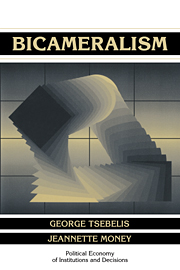Book contents
- Frontmatter
- Contents
- List of tables and figures
- Series editors' preface
- Acknowledgments
- Introduction
- PART I THE HISTORY AND GEOGRAPHY OF BICAMERAL DIVERSITY
- PART II MODELS OF BICAMERAL INSTITUTIONS
- PART III EMPIRICAL STUDIES OF BICAMERALISM AND IMPLICATIONS
- Introduction to Part III
- 6 The outcomes of intercameral bargaining
- 7 The process of intercameral bargaining
- 8 Conference committees
- 9 Implications
- Conclusions
- References
- Index
8 - Conference committees
Published online by Cambridge University Press: 02 December 2009
- Frontmatter
- Contents
- List of tables and figures
- Series editors' preface
- Acknowledgments
- Introduction
- PART I THE HISTORY AND GEOGRAPHY OF BICAMERAL DIVERSITY
- PART II MODELS OF BICAMERAL INSTITUTIONS
- PART III EMPIRICAL STUDIES OF BICAMERALISM AND IMPLICATIONS
- Introduction to Part III
- 6 The outcomes of intercameral bargaining
- 7 The process of intercameral bargaining
- 8 Conference committees
- 9 Implications
- Conclusions
- References
- Index
Summary
Conference committees are frequently employed to resolve disagreements between chambers that remain after one or more rounds of the navette. In Chapter 5, we pointed out that the importance of conference committees lies in their ability to make proposals to the parent chambers under closed rule, that is, without amendments. Consequently the details of a bicameral compromise are worked out in the conference committee, without possibility of new input from the parent chambers. Delegating the power of agenda setting to the conference committee presents the parent chambers with a serious danger, a “runaway conference” in U.S. terminology (Longley and Oleszek 1989: 4–5). The runaway conference is a conference committee that proposes compromise positions that either differ from the common positions of the chambers or exclude common positions of the chambers.
To avoid this danger, the parent chambers have two ways to rein in conference committees. The first is the explicit, restrictive, and credible specification of the set of acceptable solutions. Where the lower and upper house versions of the bill follow the same structure and disagreements are located at specific points, the conference committee may be restricted to discussing only those aspects remaining in disagreement and to locating a compromise somewhere between the positions of the two parent chambers. Conversely, where the two versions of the bill differ widely, sharing only the topic of legislation, the leeway of the conference committee expands to the maximum. In Chapter 5, we noted that since the compromise must be within the bicameral restrictions, reducing the space contained within bicameral restrictions will reduce the freedom of choice of the committee.
- Type
- Chapter
- Information
- Bicameralism , pp. 176 - 208Publisher: Cambridge University PressPrint publication year: 1997



